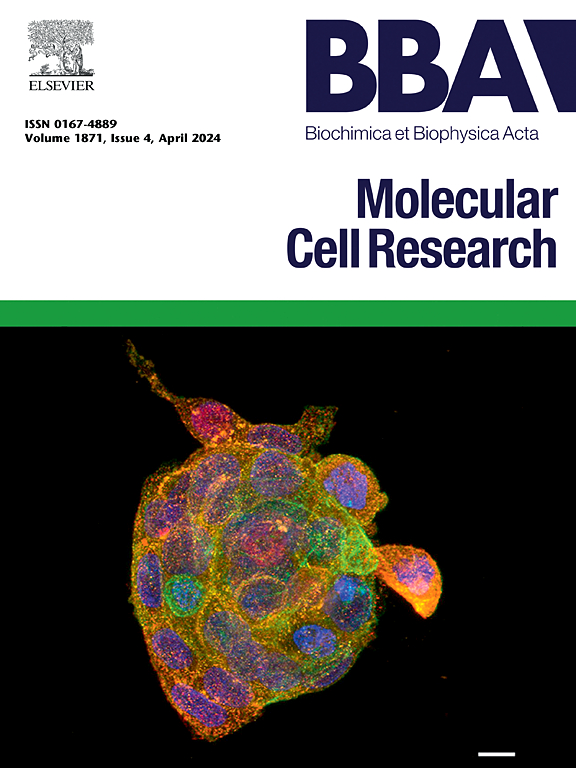巨噬细胞来源的FN1通过SDC4抑制Hippo信号通路促进胃癌腹腔转移。
IF 3.7
2区 生物学
Q1 BIOCHEMISTRY & MOLECULAR BIOLOGY
Biochimica et biophysica acta. Molecular cell research
Pub Date : 2025-09-24
DOI:10.1016/j.bbamcr.2025.120063
引用次数: 0
摘要
胃癌是世界范围内常见的恶性肿瘤。腹膜腔转移被认为是晚期胃癌的一个重要临床特征。纤维连接蛋白1 (FN1)与多种癌症的发生和发展密切相关。本研究旨在探讨FN1在胃癌腹腔转移中的作用及其机制。对单细胞测序数据集GSE140182进行生物信息学再分析,以探索恶性腹水的细胞特征。通过细胞通讯分析,确定巨噬细胞与肿瘤细胞之间的细胞通讯。用过表达FN1的巨噬细胞上清液培养GC细胞,通过WB法、MTT法、迁移侵袭法、克隆形成法、细胞粘附法和功能拯救实验研究FN1对GC细胞的作用及其可能机制。为了进一步验证FN1对胃癌及其腹腔转移的影响,我们进行了体内实验。巨噬细胞与GC细胞之间的细胞通讯是由FN1-SDC4介导的。巨噬细胞源性FN1的过表达促进了胃癌细胞的恶性表型和胃癌在体内的腹腔转移。在机制上,巨噬细胞来源的FN1通过增强GC细胞中SDC4的表达来抑制Hippo信号通路。敲低SDC4可逆转巨噬细胞源性FN1诱导的促肿瘤作用。我们的研究发现,巨噬细胞来源的FN1通过上调GC细胞中SDC4的表达抑制Hippo信号通路,从而促进GC的腹腔转移。本文章由计算机程序翻译,如有差异,请以英文原文为准。
Macrophage-derived FN1 promotes peritoneal cavity metastasis of gastric cancer by inhibiting the Hippo signaling pathway via SDC4
Gastric cancer (GC) is a prevalent malignant tumor worldwide. Peritoneal cavity metastasis is recognized as a critical clinical feature of late-stage GC. Fibronectin 1 (FN1) is closely associated with the development and progression of various cancers. This study aimed to investigate the functions of FN1 and the underlying mechanisms in peritoneal cavity metastasis of GC. A bioinformatics reanalysis of the single-cell sequencing dataset GSE140182 was performed to explore the cellular signature in malignant ascites. Cell communication analysis was performed to identify the cell communication between macrophages and tumor cells. GC cells were cultured with supernatant from FN1-overexpressing macrophages to investigate the effects and potential mechanism of FN1 action on GC cells by Western blot (WB) assay, MTT assay, migration and invasion assay, clone formation assay, cell adhesion assay, and functional rescue experiments. To further validate the impact of FN1 on GC and its peritoneal cavity metastasis were carried out in vivo experiments. Cellular communication between macrophages and GC cells was mediated by FN1-SDC4. Overexpression of macrophage-derived FN1 facilitated the malignant phenotypes of GC cells and the peritoneal cavity metastasis of GC in vivo. Mechanistically, macrophage-derived FN1 inhibited the Hippo signaling pathway by enhancing the expression of SDC4 in GC cells. Knockdown of SDC4 reversed the tumor-promoting effects induced by macrophage-derived FN1. Our study revealed that macrophage-derived FN1 inhibited the Hippo signaling pathway by upregulating the expression of SDC4 in GC cells, thereby promoting peritoneal cavity metastasis of GC.
求助全文
通过发布文献求助,成功后即可免费获取论文全文。
去求助
来源期刊
CiteScore
10.00
自引率
2.00%
发文量
151
审稿时长
44 days
期刊介绍:
BBA Molecular Cell Research focuses on understanding the mechanisms of cellular processes at the molecular level. These include aspects of cellular signaling, signal transduction, cell cycle, apoptosis, intracellular trafficking, secretory and endocytic pathways, biogenesis of cell organelles, cytoskeletal structures, cellular interactions, cell/tissue differentiation and cellular enzymology. Also included are studies at the interface between Cell Biology and Biophysics which apply for example novel imaging methods for characterizing cellular processes.

 求助内容:
求助内容: 应助结果提醒方式:
应助结果提醒方式:


